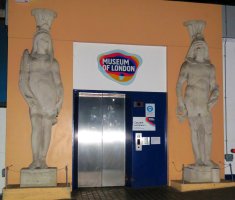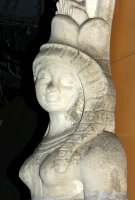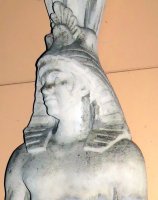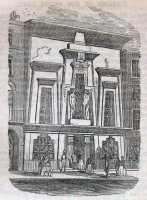Egyptian Hall Statues, by Sebastian Gahagan
The statues of Isis and Osiris from the 1812 Egyptian Hall in Piccadilly survived its demolition in 1905, and are in the collection of the London Museum. The sculptor was Sebastian Gahagan, best known today by his surviving statue of the Duke of Kent in Portland Place.
I went to see the statues of Isis and Osiris because of an interest in the sculptor Sebastian Gahagan. It makes a bit of a story. Gahagan, one of a family of sculptors (see this page) has a major surviving statue in Portland Place, just down the road from Madame Tussauds, on the south side of Marylebone Road opposite Regents Park. Anyone following up on Gahagan, as I did, quickly comes across his architectural statues for the Egyptian Hall, Piccadilly, built in 1812 - there are many pictures of this building, believed to be the first in Egyptian style in London, showing the statues in rather cursory fashion. I knew they had survived the building’s demolition and ended up on the exterior wall of the London Museum, but never noticed them on visiting. Spurred on by the fact that the London Museum is to be rehoused from the brutalist Barbican at the end of 2022, I bestirred myself to find the statues, by the expedient of asking the young lady at the entrance to the Museum. Within seconds she had acquired the familiar glazed look that people normally acquire when asked if they have seen a couple of 10ft high 200 year old statues in the vicinity. Her older colleague drifted up, however, and immediately knew what I was after. She did not recall anyone asking about them, she said, and it was unlikely that even many of the staff would particularly come across them, given their location. She informed me that they were by a service lift in a lower layer of the Barbican complex, and took me outside to point the way. Good that she did. Down a coiled staircase by a bit of the Roman London wall, then down underground through a vehicle entrance with a narrow walkway on one side. And after some little way there indeed were the statues, on either side of the lift.
The statues
Three views of Isis (click to enlarge).
The two statues are made of artificial Coade Stone, and as can be seen from the picture at the top of the page, are of prodigious size, perhaps 12 ft tall plus the bases and pillar capitals on their heads. The female goddess, Isis, is on the left, Osiris on the right, and while their bodies are more or less frontal to the viewer, their heads are turned to face a little towards each other, and their outer feet are forwards, again to unify the composition. Originally, they stood within a broad window with a raised centre, so acting as supports for the side portions, thus caryatids (strictly an atlante for the male figure), and hence the capitals on their heads.
Isis stands slightly contrapposto, with shoulder slightly raised on the outer side, while resting her weight on the opposite leg, with hip slightly raised, giving a nice feminine curviness to her figure, undisturbed by her very short, very light garment. Her face is quite round, with large, heavy features, rather than the sharply delineated chin and high cheekbones we associate with many ancient Egyptian statues, but there is an older style which has something of this look. She wears a headdress, has a triple necklace, and has the small, high breasts and muscular arms familiar from many ancient Egyptian statues. In one hand she carries a long palm frond cradled against her arm, and in the other hand holds what seems to be a bell shaped flower with a few leaves.
Osiris is a heavily muscled male figure, and in proper Egyptian style, his upper body is more muscular than his legs, though we do not see the triangular chest sometimes found. We certainly see more of him, for he wears just a short Egyptian kilt, and a headdress somewhat broader than Isis’s, with the ends resting on his shoulders. He carries a very short ankh (circle with cross at the base), which has much symbolism associated with it, but here represents the union of Osiris and Isis (also called the key of the Nile, as supposedly when they coupled, the Nile flooded; the ankh thus also is used as a symbol of fertility, and also eternal life, in which aspect it was later appropriated by the Coptic Christians). In his right hand, Osiris holds a small crocodile, crawling on the crook of his arm, with the tail loosely held so that the little beast cannot fall. In one telling, Isis healed Osiris with the aid of a crocodile or crocodile god, and of course the crocodile is another association with the Nile.
Osiris and crocodile.
The statues are quite broadly treated, without fine detail, and the surfaces somewhat pitted and scarred - these were outdoor statues designed to be seen from some distance below rather than closely examined, and were after all for an entertainment venue. However, the poses are excellent, the crocodile a pleasure, and it is a goodness that these statues have survived.
As noted earlier, a little more on the sculptor, Sebastian Gahagan, and his family, on this page. And if you like crocodile sculpture, see this page.
The Egyptian Hall
A bit more now about the Egyptian Hall. It stood opposite Burlington arcade next to the Royal Academy at nos. 170-171 Piccadilly. It had been built for William Bullock, a collector who originally established a museum in Liverpool in about 1800, showing a collection of curiosities, zoological, botanical and medical specimens, and armour, which he later brought to London. It was popular enough that he decided on a permanent exhibition hall, which he had built in Egyptian style, after the temple at Tentyra [Dendera], from 1811-12: the architect was Peter Frederick Robinson (who later designed the Swiss Cottage). I found the sketch of the frontage shown here in a catalogue for the 1851 Great Exhibition I happened to have kicking around; there are many rather more detailed pictures online. The building was originally known variously as Bullock's Museum, the Egyptian Hall or Museum, the London Museum, and other things later, but it was Egyptian Hall that stuck.
The Egyptian Hall in 1851.
Bullock auctioned off his original collections in 1819, but kept the Egyptian Hall as an exhibition space, and with a penchant for collecting trips abroad, including to South America, brought back further material for show and sale, before selling the building in the late 1820s. Much of his collections seem to have gone abroad, with ethnographic collections being taken by the Berlin Museum, and the arms and armour ending up in the collection of Frederic Spitzer, a London dealer who relocated to Paris in the 1860s. But Bullock's Mexican artifacts from his 1822/23 expedition mostly went to the British Museum, and a great sarcophagus brought from Egypt by the Italian strongman Belzoni survives in the basement of the Soane Museum. Some non-artistic part of the collection also stayed in England, notably zoological specimens which made their way to the Royal Society of Surgeons collection. And when Spitzer, who had bought the armour, died, and the majority of his collection was auctioned off in 1893, it seems much of the armour was bought by the Crown and is now in the Wallace Collection back in London (while the forged artworks in Spitzer's collection seem mostly have been snapped up by the more disingenuous American institutions).
Anyway, after Bullock's time, the Egyptian Hall was used for exhibitions and various entertainments and shows of varying degrees of aestheticism through to vulgarity. Notably from an artistic viewpoint, we must mention that the painter B.R. Hayden exhibited works here, though 'totally neglected due to the exhibition at the same time… of the Ojibbeway Indians and the American dwarf, Tom Thumb ... a circumstance which hurried the lamented artist to a premature grave.' J.W.M. Turner exhibited there more successfully, also the Dudley Gallery, and the Egyptian Hall hosted the New English Art Club's first exhibition of watercolours. The sculptor J.G. Lough showed works there in 1830. Other artistic exhibitions included for instance Panoramas, one of American interest, being 'a moving Diorama of Fremont's Overland route to Oregon, Texas and California', and also Albert Smith's Mont Blanc ascent. I have to mention en passant that a mermaid skeleton was exhibited in the Hall, having been manufactured from a monkey upper and piscine lower portion. Later on, exhibitions faded away and the Egyptian Hall was used exclusively for performances, outwith the concerns of this website. The building was demolished in 1905, and replaced as part of a larger site by 166-173 Piccadilly, a rather bland Edwardian building which, in memory of the Egyptian Hall, is still called 'Egyptian House'.
This site includes information about sculpture in Piccadilly today on this page.








